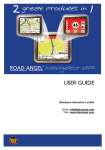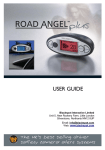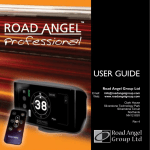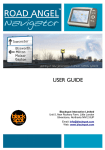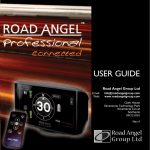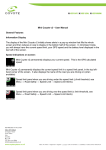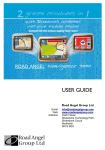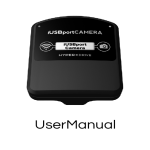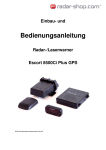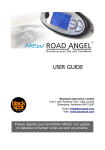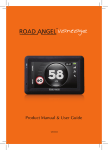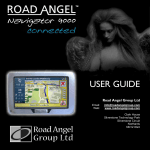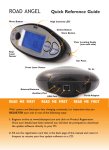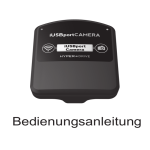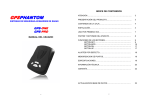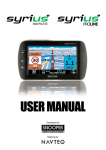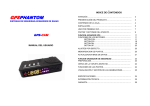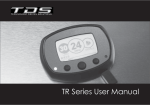Download ROAD ANGEL Gem manually
Transcript
USER GUIDE Thank you for choosing ROAD ANGEL Gem As our roads become busier, more congested and more regulated, staying alert to road and traffic conditions is a challenge to everyone. Even the most conscientious driver can have a momentary lapse of concentration that could easily lead to an accident or a fine and points. ROAD ANGEL Gem is specially designed to be a simple-to-use addition to any vehicle, to alert and warn you in advance of known danger areas. In the comprehensive ROAD ANGEL Gem database, which is automatically updated whilst you drive, are stored Police, Local Authority and Ministry of Transport designated danger spots, including accident blackspots and safety camera locations. Using the latest Global Positioning Satellite (GPS) technology, ROAD ANGEL Gem compares your position with the known danger spot locations and gives you an audible and visual warning as you approach them. An accurate GPS speedometer in the display gives you time to adjust your driving to the approaching danger. With over 250,000 miles of road around the UK, knowing the speed limit is often guesswork. Gem also has an onboard database of road speed limits, so you will know what the speed limit is, at a glance. Join other ROAD ANGEL Gem users in guarding your life and livelihood. The safety of you and your passengers is our prime consideration, and we trust that for all the miles you drive, your ROAD ANGEL Gem will enhance the safety and enjoyment of your journey. In the event of an accident or incident, you can contact the emergency services at the press of a button using eAssist, a feature unique to the ROAD ANGEL Gem. We are pleased to have you as a valued customer and hope you will be delighted with your fully integrated ROAD ANGEL Gem. Having listened to our customers we think the new features will make this product your perfect driving companion. Mark Thickbroom Chief Executive Officer Road Angel Group Ltd. Quick Start Guide IMPORTANT! As soon as possible, register your ROAD ANGEL Gem and purchase subscriptions at: www.roadangelgroup.com. Until you do so, the unit cannot update its database with the latest road speed and camera information and eAssist will not function. 1. Mount the ROAD ANGEL Gem in your vehicle. 2. Switch the unit on. Use the supplied dash mount pad (it has an adhesive backing). Connect ROAD ANGEL Gem to your vehicle’s cigar socket using the supplied cable and adapter. Until the battery charge reaches the minimum level required to run the internal software (this might take up to an hour) your ROAD ANGEL Gem displays a splash screen with a battery charging progress indicator. Power button TIP: Use the mains charger to speed up this step. Charge the unit at home for 24 hours if possible. 3. The ROAD ANGEL Gem searches for satellites to establish its location. TIP: Make sure the unit has a clear view of the sky, away from obstacles such as tall buildings and over-hanging trees. 4. ROAD ANGEL Gem is ready for use! IMPORTANT! Until the unit has received a SIM update and has GPRS connectivity, it will be unable to update its database with the latest road speed and alert information. GSM signal strength GPRS signal/ SIM updated Database updating i Road Speed Data For many years, you have been asking us to help you understand the current legal speed limit of the roads you are driving, regardless of the presence of a safety camera or obvious road signage. However, once we started looking into this we were amazed that there is currently no definitive digital speed limit database for the UK’s roads. With over 250,000 miles of roads, collecting all of this data ourselves would have been an enormous job costing millions of pounds and, much like painting the Forth Bridge, would need constant attention year on year. For the Road Angel Gem we’ve teamed up with Navteq™, owned by Nokia, to use the road speed limit database supplied as part of their navigation product suite. This ensures that we have all the major roads covered and get to hear when a new road or dual carriageway is being built. We realise that the data supplied by Navteq is not 100% accurate as local authorities are free to amend national speed limit recommendations as they see fit. This is why we have created SpeedShare™ which lets you, our customers, suggest new or revised road speed limits at the press of a button. We have been doing something similar with our Professional Connected and Vantage customers for the last few years using our CameraShare™ feature, as it gives us 10,000’s of eyes and ears out there – all happy to tell us when a new safety camera has been installed or a mobile camera van has parked up. Once you report an anomaly with the road speed database, our dedicated team investigate the piece of road in question and adjust, where appropriate, the speed limit in our master database, ready to download to you next time you update. Over time, we are confident that we will start to develop the only truly accurate picture of legal road speed limits in the UK. Thank you in advance for helping us in this endeavour. ii Contents Quick Start Guide Road Speed Data 1. 2. 3. 4. 5. 6. i ii Introduction 1 Unpacking the Box Warranty Battery Power and Recharging Controls and Connectors Front view Rear view 3 4 4 5 5 6 Registration 7 Charge the Unit Register your Unit Online Subscriptions The SIM Update 7 7 8 9 Installation 10 Security Mounting the Unit Attaching the Power Lead Hardwiring 10 11 12 12 Getting Started 13 Switching On for the First Time Normal Use 13 14 Alerts 15 Advisory Colour Coding Examples of alerts and advisory colour coding 16 17 Customising ROAD ANGEL Gem 19 Audio Options 20 iii 7. 8. 9. 10. iv Alert Options Display Options Unit Data 21 22 23 Adding Danger Zones 24 Adding New Locations 24 eAssist 26 Manual Activation Automatic Activation Speaking to the SOC Operator 26 27 27 Updating the Database 29 The ROAD ANGEL Database Automatic Updates by GPRS Updating by PC 29 29 30 Background Information 31 About Global Positioning Satellites (GPS) Our Camera Database Laser Detection How mobile laser traps operate How the enforcement officer chooses which vehicles to target ROAD ANGEL Gem and the Law Targeting Explained Short range targeting Long range targeting Following a vehicle being targeted Speed Cameras and Hazards 31 31 32 32 32 32 33 33 34 34 35 1. Introduction ROAD ANGEL Gem is a standalone GPS camera and accident blackspot locator. It uses the latest global positioning satellite technology (see page 31) to give you audible and visible alerts as you approach hazardous sections of road: Accident blackspots (as designated by the Police and Local Authorities) Safety cameras Mobile roadwork cameras Average speed monitoring zones Mobile safety vans Mobile laser guns Primary schools, congestion charging zones and unprotected level crossings With over 250,000 miles of road around the UK, knowing the speed limit is often guesswork, that’s why Gem also has an onboard database of road speed limits. Provided by Navteq™, the road speed information is presented in a circular road speed sign at the bottom left of the device. By using mobile phone technology, Gem also allows you to both share the LIVE locations of mobile safety camera vans, and to suggest new or revised road speed limits. CameraShare™ and SpeedShare™ are two unique features to Road Angel, and empower you to keep yourself, and other Road Angel users, safe on the roads. eAssist™ allows you to connect to emergency services through a Secure Operating Centre (SOC) in the event of an accident or incident. Simply press the eAssist button to speak with the SOC operator through a microphone built into the ROAD ANGEL Gem. Your ROAD ANGEL Gem communicates your precise location to the SOC operator (in areas with good GPS coverage). eAssist™ can also be triggered automatically by a collision. The Gem device has an onboard ‘g-meter’ that measures your vehicle’s acceleration or deceleration. If the gforce is above a certain threshold indicative of a collision, the SOC is automatically contacted unless you cancel the eAssist™ call within 10 seconds. 1 IMPORTANT! The directors of Road Angel Group Ltd sell ROAD ANGEL Gem as a road safety device. Driving within the speed limits at all times and within the limitations of the road condition and your abilities is paramount. The directors of Road Angel Group Ltd take no responsibility for the use of ROAD ANGEL Gem for purposes other than those stipulated. Placement Position your ROAD ANGEL Gem as low as possible on the dashboard (see page 11) so that it does not impair your all-round visibility: we recommend you use either a central position or by the A-post. The device should be mounted securely and all cables must be trained via locations that do not impact any vehicle controls and importantly, do not impede the intended operation of any Air Bag zones. Do not leave the device in position when you leave the vehicle unattended, both for security reasons (see page 10), and to avoid heat damage resulting from direct sunlight. MOT Examinations For vehicles undertaking MOT examinations, Road Angel or any dashboard mounted device should either be removed, or adhere to the rules and regulations on positioning. This normally restricts placement within the swept (windscreen wiper) area of the screen, located as low as practical to minimise potential loss of visibility. Safety Road Angel driver safety systems are designed with the sole purpose of making drivers more aware of vehicle speed, the environment and potential hazards ahead. To ensure Road Angel provides this information effectively and without distraction, devices incorporate both visual and verbal instructions on the potential hazard, along with in some cases, colour coded screens to remove the need for the driver to take their eyes from the road ahead. Under no circumstances should Road Angel products be operated by the driver whilst the vehicle is in motion. Road Angel devices are aimed at increasing driver awareness and should always be considered secondary to the primary purpose of driving the vehicle. eAssist Please note that the eAssist function is not designed to save your life, nor act as a replacement to existing safety and / or emergency services. It is designed to complement existing protocols and provide extra peace of mind for drivers. We do not guarantee that eAssist will work 100% of the time, due to factors outside of Road Angel Group’s control (see page 28 for more details). 2 Unpacking the Box Empty all the parts out of the box and familiarise yourself with each item. Each pack contains: ROAD ANGEL Gem Mains charger with connector for USB cable Dash mount cradle USB cable Connects Gem to mains charger, car charger or PC USB port. 12V/24V cigar socket charger Connects unit to cigar socket for in-car power and trickle charge. 3 Warranty Your ROAD ANGEL Gem is guaranteed for one year from the date of purchase from all manufacturing defects that occur with normal use. If your unit fails to perform as specified in these instructions, please visit: https://www.roadangelgroup.com/warranty.aspx Battery Power and Recharging IMPORTANT! Before you start to use your new ROAD ANGEL Gem, we recommend that you fully charge it to preserve battery life and performance. For optimised charging, use the mains charger and ensure that the unit is switched off. It will take longer to recharge the battery if the unit is in use. In addition, the in-car cigar lighter adapter provides a less efficient ‘trickle’ charge. It may take 24 hours to fully charge a unit in this way compared with only 4 hours using the mains charger. ROAD ANGEL Gem is a cable-free device; it can operate independently using power from its internal rechargeable battery for up to 3 hours. You can also power ROAD ANGEL Gem directly from the cigar socket in your vehicle. Less than 20% Charging 20% 40% 60% 80% Full The unit’s battery level is indicated by the battery icon on the left side of the display (see page 14). The number of blocks shown indicates the current battery strength. You can charge the battery using either the in-car cigar lighter adapter or the mains charger. There is no need to wait until the battery is completely flat, unlike some rechargeable devices. During the last 30 minutes (approx) of battery life, you will receive 3 separate warnings that the battery is low. The third and final warning is issued moments before the battery is completely drained and the unit shuts down. When the unit is switched off and not in use, a full charge will last for up to a week. If the battery is completely discharged, it may take up to an hour to recharge to the minimum level required before the ROAD ANGEL Gem can start (see page 7). 4 Controls and Connectors This section shows the main features of your ROAD ANGEL Gem. Front view Visor Reduces glare on the screen. Store button Add new zone to database. OK button Accept menu options. eAssist button Contact eAssist operator. Magnetic base Secures ROAD ANGEL Gem to dash mount cradle. Scroll up Scroll through menu options. On/Off/Menu Long press switches unit on/off; short press when on opens settings menu. Scroll down Scroll through menu options. Dash mount cradle Mounting pad to secure unit to dashboard (adhesive backing). 5 Rear view Laser sensor Detects laser speed measurement devices targeting front of vehicle. USB connector Connect to mains charger or cigar lighter adapter using supplied cable. 6 2. Registration IMPORTANT! To get the full benefit of up-to-the-minute safety information, you should put the unit on charge, register online and then wait for a SIM update. As part of this process, you will be prompted to purchase subscriptions to the safety camera & blackspot and road speed limit databases. Having a valid subscription will ensure you have the very latest information on your device. Charge the Unit With the unit switched off, connect it to the mains charger and charge the internal battery. Until the battery charge reaches the minimum level required to run the internal software (this might take up to an hour), your ROAD ANGEL Gem displays a splash screen with a battery charging progress indicator. When the battery is fully charged, the battery charge indicator (see page 14) is green. Register your Unit Online 1. Go to www.roadangelgroup.com 2. Click on the Registration link. 3. Follow the on-screen instructions. As part of this registration process, you will be prompted to purchase subscriptions for the safety camera & blackspot and road speed limit updates. You can also register by phone: call 01327 855586 (Mon-Fri 9am-5.30pm). 7 Subscriptions Your ROAD ANGEL Gem uses the award-winning Road Angel camera and accident blackspot database. It is critical to the operation of your ROAD ANGEL Gem that your unit updates regularly and so continued subscription is essential. Current subscription rates can be found at www.roadangelgroup.com. Why do you need to subscribe for updates? With constant additions to the ROAD ANGEL camera and accident blackspot database (1000+ sites per year), the benefit of your ROAD ANGEL Gem and the protection it provides will be dramatically reduced if you fail to remain subscribed. In this instance, your automatic updates will be disabled. It is critical to the operation of your ROAD ANGEL Gem that your unit updates regularly. In areas of low GPRS coverage, manual updates may be necessary (see page 30). + How do you subscribe? You can choose from 6, 12 or 36 month subscription plans, paying by credit or debit card during the registration process. Please be aware that all subscriptions are non-refundable and non-transferable. How long will it take to activate your subscription? Following the purchase of your subscriptions, you will start receiving automatic updates to the safety camera & blackspot database, and be able to download updates to the road speed limit database via PC, within 24 hours (following SIM activation by Orange – see below). Do you need to subscribe to use eAssist? Yes, eAssist will not work unless your unit has a valid subscription. 8 The SIM Update 1. Switch on your ROAD ANGEL Gem by pressing the button on the front of the unit. Place the unit in a location where there is a GSM signal as indicated by the icon on the right of the screen. 2. When your unit has been registered, it will receive a SIM update from Orange within the next 24 hours (as long as the unit is on and has a GSM signal). The unit will then restart. 3. When the unit has completed the SIM update, the bars by the GSM/GPRS icon turn green to indicate GPRS connectivity. 4. Your unit will now perform a database update as indicated by the ‘communicating’ icon: 9 3. Installation We recommend that you install your ROAD ANGEL Gem on the dashboard of your vehicle, using the supplied dash mount cradle. This has been designed for secure mounting and quick release. ROAD ANGEL Gem requires a clear view of the sky to receive information from GPS satellites. We highly recommend that ROAD ANGEL Gem is positioned in the centre of the front windscreen, low down, just above the dashboard (see page 2). If screen glare is a problem in this position, try installing the unit beside the driver's “A-pillar”. Check that the GPS reception operates correctly in this position. UV/solar reflective screens block GPS signals from entering the vehicle and may affect the operation of your ROAD ANGEL Gem. Please allow extra time for your unit to acquire its position. Heated screens can also affect GPS signal strength. IMPORTANT! Security Owing to the high number of thefts, we strongly recommend that you remove your ROAD ANGEL Gem from view when you leave your vehicle. Before storing the unit (for example, in the glove compartment), ensure that it is switched off to avoid the possibility of accidentally triggering the eAssist feature (see page 26). Please contact Road Angel Group Ltd if your unit is stolen or lost. Each ROAD ANGEL Gem is identified by a unique serial number on the back. We can use this number to block the unit from being updated. Any attempt to do so removes all the data from the device and renders it useless. We can also detect any attempt to re-register it. 10 Mounting the Unit ROAD ANGEL Gem is supplied with a dash mount cradle allowing you to mount the unit directly on the dashboard. Ensure that your ROAD ANGEL Gem is not located close to any heater vents. 1. Using the supplied wipe, clean the area where you want to attach the dash mount cradle. Allow the area to dry. 2. Peel the backing from the adhesive on the base of the dash mount cradle. 3. Press the dash mount cradle firmly onto the dashboard. 4. Leave the dash mount cradle for 24 hours so the adhesive can set properly. 5. Attach the ROAD ANGEL Gem onto the dash mount cradle. 6. Adjust the angle and position of the unit so that you have a clear view of the screen when driving. 11 Attaching the Power Lead 1. Take the power lead, and plug it into the USB port on the back of the unit. 2. Route the power cable to the cigar lighter socket. Ensure that it does not interfere with any of the vehicle's controls or airbag modules. If you use your cigar lighter socket for any other devices, a dual adaptor may be used. You are now ready to use the unit for the first time. Hardwiring To hardwire ROAD ANGEL Gem into your vehicle, purchase a compatible cigar socket from www.roadangelgroup.com; wire this into the power system and use with the supplied cable. Select the Hardwire Mode option in the Display Options (see page 22) if you want your unit to switch on automatically when it detects power. IMPORTANT! ROAD ANGEL Gem has a 5V regulator built into its power cable. If the cable is cut and used to hardwire the unit into the vehicle, you will damage the ROAD ANGEL Gem and void your warranty. Consult an auto electrician if you are unsure how to carry out this procedure as incorrect hardwiring may affect the validity of vehicle and product warranty. Consult vehicle manufacturer if in doubt. 12 4. Getting Started Switching On for the First Time 1. Find a location with a clear view of the sky (away from obstacles such as tall buildings and overhanging trees – these may delay or prevent satellite acquisition). 2. Switch on the ROAD ANGEL Gem by pressing the power button for about two seconds. 3. If you skipped registration (see page 7) your ROAD ANGEL Gem will not have updated its database and the screen will show the registration prompt. Press the Dismiss button to continue (please register as soon as possible). 4. ROAD ANGEL Gem now tries to identify its location by acquiring information from GPS satellites. This may take a few minutes. During the procedure, the unit displays the “Searching for Satellites” screen. 5. With further use, the unit should establish your location within 1-2 minutes of being switched on. 6. When ROAD ANGEL Gem has established its position, the display shows your speed (0 if you are stationary) and the speed limit for your current location. 13 Normal Use Your unit is now ready for use. You can start driving and ROAD ANGEL Gem will show your speed and the road’s speed limit. “Connected” icon indicates live updating Battery power level GSM signal strength/ GPRS connectivity GPS signal strength Vehicle speed (shown on blue background if you are within the advisory speed limit). Advisory speed limit. If you are approaching a known hazard, ROAD ANGEL Gem will alert you to the type and proximity of the hazard (see page 15). 14 5. Alerts Your ROAD ANGEL Gem alerts you to: Fixed, temporary or average speed camera locations. Mobile safety van locations (with the ‘Live Van’ facility). Hazard locations: accident blackspots, schools, or congestion charging zones. Proximity-to-hazard meter Vehicle speed Alert type Alert type icon Camera warnings only: Advisory speed alternates with Alert type display Speech warnings will tell you the type of hazard (for example: “Warning, laser, laser”) followed by an audible tone that increases in frequency with your proximity to the location. A proximity-to-hazard meter increases from 1 to 5 bars as you get closer to the danger zone. If it is a fixed, temporary or average speed camera location, the unit alerts you to the advisory speed limit. You can customize the way your ROAD ANGEL Gem alerts you to road dangers: see page 19. 15 IMPORTANT! USE THE ADVISORY SPEED LIMIT FOR GUIDANCE ONLY. Any road speed limit can change without prior notice or consultation, for example, in temporary road works. It remains important for drivers to constantly re-evaluate and be aware of the road limit at all times. Speed limits may vary according to vehicle type and class. All Road Angel products are designed to provide the driver with a high visibility speedometer reading within your field of vision. Although GPS speedometers are known to be highly accurate at steady speed, atmospheric conditions and hindered skyward visibility (e.g. tunnels) can adversely affect accuracy. In all situations, drivers should always refer to the vehicle’s speedometer, which is known to fall within approved guidelines of accuracy in all situations, and be aware of the applicable speed limit. Advisory Colour Coding In addition to the audio warnings and alert icons, your ROAD ANGEL Gem also changes the colour of the speed display to provide at-a-glance information about the road ahead. Blue/Unchanged You are approaching a fixed, temporary or average speed camera location but travelling below the advisory speed limit. Red You are approaching a fixed, temporary, ‘live’ mobile or average speed camera location travelling above the advisory limit. If your speed subsequently drops below the advisory speed limit, the speed is displayed in the normal green colour. Orange You are approaching a mobile van location. Purple You are approaching a hazard for which an advisory speed is not available: accident blackspot, unprotected level crossing or a Primary school. 16 Examples of alerts and advisory colour coding Normal screen, no alerts, vehicle travelling below advisory speed Fixed camera alert, vehicle travelling above advisory speed Fixed camera alert, vehicle travelling below advisory speed Road blackspot alert Average camera zone, vehicle travelling above advisory speed Average camera zone, vehicle travelling below advisory speed Live van alert, vehicle travelling above advisory speed Live van alert, no advisory speed data available Mobile camera or laser targeting alert, no advisory speed data available 17 Examples of alerts and advisory colour coding (continued) Congestion zone alert Low bridge alert School zone alert Railway crossing alert Overspeed limit exceeded Fatigue time limit exceeded 18 6. Customising ROAD ANGEL Gem You can change the way ROAD ANGEL Gem works by adjusting its menu settings. During normal operation, click on the Power button on the right side of the screen. Menu settings cannot be changed during an alert. Audio Options Choose how ROAD ANGEL Gem uses audio prompts to alert you to road dangers. Alert Options Enable or disable optional alert types. Display Options Choose day/night display settings, hardwired mode and auto standby options. Unit Data View technical information about your ROAD ANGEL Gem: its serial number, firmware version, subscription expiry date and the date of the most recent database update. Use the arrow buttons to highlight a menu and then press the button to display its options. After several seconds of inactivity on a menu screen, the display will return to normal mode. 19 Audio Options Settings in the Audio menu determine how ROAD ANGEL Gem uses audio prompts to warn you about road hazards. Property Details Options (factory setting in bold) Voice Type Choose male or female voice for alerts Male…Female Camera Alert Volume Change the sound level of safety camera related warnings. 0…100% (80%) Safety Alert Volume Change the sound level for Blackspot, School and Congestion related warnings. 0…100% (80%) 20 Alert Options Settings in the Alerts menu determine how ROAD ANGEL Gem warns you about road hazards. Property Details Options (factory setting in bold) Blackspot Switch Blackspot alerts on or off. Off…On Camera Van Switch mobile van alerts on or off. Off…On Congestion Zone Switch Congestion zone entry warnings on or off. Off…On Fatigue Switch the fatigue timer alert on or off. Off…On School Zone Switch School alerts on or off. Off…On Overspeed Set your own maximum speed: the unit will alert you if you exceed it. Warning Dist. Adjusts the warning range as you approach danger zones (except Mobile Van alerts: fixed at 500m). Speed Sen. Dist. Doubles the Alert Distance at 50MPH and above (except Mobile Van alerts: fixed at 500m). Off…25…30…40…50 …60…70…80 250…500…750…1000m Off…On 21 Display Options Using this menu, you can change the appearance of the display, including the display mode (day or night), hardwire mode, and auto standby settings. Property Details Options (factory setting in bold) Display Mode Adjust the contrast of the ROAD ANGEL Gem display. Day…Night Hardwire Mode When enabled, unit switches on automatically when it detects power. Off…On Auto Standby To reserve battery power, unit automatically switches off if it has not been moved within the specified time. Off…30 sec… 2 min...5 min...10 min 22 Unit Data This menu provides technical information about your ROAD ANGEL Gem: its serial number and firmware version, the expiry date of your subscription and the date of the most recent database update. Property Details Options (factory setting in bold) Serial No. Serial number of ROAD ANGEL Gem unit. Read only; 8 digit number Firmware ROAD ANGEL Gem firmware version. Read only, in format x.xx Sub. Expiry Date when subscription expires – displayed after update. Read only; in format DD/MM/YY Last Update Date when the unit’s database was last updated. Read only; in format DD/MM/YY 23 7. Adding Danger Zones Road Angel Group Ltd is constantly updating the central database of danger zones. You can be of great value to the users of other GPRS-enabled ROAD ANGEL devices by setting ‘Live Van’ and other alerts. Also, by submitting new zones for verification, you can contribute to the safety of the whole community of ROAD ANGEL device owners. CAUTION! PLEASE ONLY ADD ALERTS WHEN IT IS SAFE TO DO SO. Adding New Locations You may add new FIXED CAMERA, MOBILE CAMERA, AVERAGE SPEED ZONE, SCHOOL ZONE, ROAD BLACKSPOT and CAMERA VAN locations to your ROAD ANGEL Gem database. In addition, you can also set a new road speed limit (the current limit may be incorrect due to road works, for example). When your ROAD ANGEL Gem updates, these new locations will also be downloaded to the central database, and can then be verified by the ROAD ANGEL team for possible inclusion in future updates. 24 To add a location or new road speed: 1. Tap on the + button. This will confirm your location and heading. If you intend to add an Average Speed Zone to the database, ROAD ANGEL Gem will take this position as the start of the zone. ROAD ANGEL Gem needs to be travelling in excess of 4 MPH to calculate the heading for a location. 2. Scroll to and select the alert type from the following options: Revised Road Speed Fixed Camera Mobile Camera Average Speed Zone School Zone Road Blackspot Camera Van 3. Select the speed limit for the alert from the following options: 20, 30, 40, 50, 60, 70MPH or UNKNOWN. Tap on the button. 4. If you are recording an Average Speed Zone, wait until you are at the exit of the zone and then tap on the + button. The unit will terminate the zone automatically after 6 miles. The location is now stored on your unit for future use. When your ROAD ANGEL Gem updates, the location will be downloaded to the central database to be verified by the ROAD ANGEL team for possible inclusion in future updates. 25 8. eAssist In the event of an accident or incident, your ROAD ANGEL Gem’s eAssist feature allows you to contact emergency services via the Secure Operating Centre (SOC). There are two ways to trigger the eAssist feature: Manually, by pressing the ‘e’ button. Automatically, through a ‘g-event’ – a sudden acceleration or deceleration indicative of a collision. IMPORTANT! The device must have a valid subscription: eAssist will only work if you have purchased subscriptions for the device. Manual Activation To speak to the operator at the Security Operating Centre: 1. Press and hold the ‘e’ button (see page 5) for 3 seconds. This initiates both a voice and visual prompt (confirmation) asking you to confirm that you want to connect to the SOC. 2. Press the ‘e’ button again (for any length of time) to connect to the SOC. If you take no further action within 10 seconds the eAssist call is terminated. Hold e button for 3s 26 Press tick to confirm Cancel within 10s or SOC call initialised Automatic Activation ROAD ANGEL Gem has an onboard ‘g-meter’ that measures the g-force the unit is experiencing. If the g-force is above 1.5 to 2g, values typical of a vehicle collision, a message will appear on the screen stating that the SOC will be automatically contacted if you do not cancel the eAssist call within 10 seconds. Press the ‘e’ button within the 10 second window to cancel the call. IMPORTANT! Please treat the ROAD ANGEL Gem with care: throwing or dropping the device may accidentally trigger an eAssist call. Speaking to the SOC Operator Once connected with the SOC operator, speak through the microphone built in to the ROAD ANGEL Gem. You cannot cancel the call after a connection has been made – only the SOC operator can terminate the call. If you are in a location with good GPS coverage, there’s no need to explain where you are: the SOC operator will know your location from the GPS information communicated automatically by your ROAD ANGEL Gem. IMPORTANT! If, for any reason, your ROAD ANGEL Gem is unable to connect to the SOC Operator but has mobile phone coverage, it will automatically dial 999 instead (providing that you have a valid subscription). 27 IMPORTANT! Please note that the eAssist function is not designed to save your life, nor act as a replacement to existing safety and / or emergency services. It is designed to complement existing protocols and provide extra peace of mind for drivers. We do not guarantee that eAssist will work 100% of the time, due to factors outside of ROAD ANGEL GROUP’s control. Such factors include, but are not limited to: The device having an invalid subscription – eAssist will only work if the user/owner has purchased subscriptions for the device. ROAD ANGEL has disabled eAssist on your device due to too many false calls to SOC. Poor, limited or no mobile phone (GPRS or GSM) coverage. Poor, limited or no GPS signal. Low battery charge resulting in the substandard or reduced performance of the device. The device being switched off - eAssist will only work if the device is switched on. If there is a problem with the call including distortion, drop-out, or general problems and/or issues with the mobile phone network (if the device is unable to contact SOC it will attempt to call 999 instead). If the unit has been damaged in an incident, rendering the eAssist feature inoperative. Faults within the device due to incorrect installation or modification. Other general manufacturing faults of the device. We recommend that ROAD ANGEL Gem is connected to a power supply within the vehicle at all times when in use, either by using the supplied 12 volt ‘cigar’ charger or by hardwiring the unit into the vehicle using a hardwire kit. When your ROAD ANGEL Gem is not in use, ensure that the unit is switched off to avoid the possibility of false alerts. ROAD ANGEL GROUP will not be held liable for any injuries or deaths resulting from the use, misuse, or substandard performance of the eAssist feature, or the ROAD ANGEL Gem product in general. 28 9. Updating the Database The ROAD ANGEL Database ROAD ANGEL Gem uses a database of Police, Local Authority and Ministry of Transport designated danger spots, including accident blackspots and safety camera locations, primary schools and congestion charging zones. Using the latest Global Positioning Satellite (GPS) technology, ROAD ANGEL Gem compares your position with known danger spot locations and gives you an audible and visual warning as you approach them. It is critical to the accurate operation of your ROAD ANGEL Gem that your unit is regularly updated to maintain the very latest data. To qualify for database updates: 1. Register your ROAD ANGEL Gem with Road Angel Group Ltd. You cannot receive updates until you have registered (see page 7). 2. Purchase a valid subscription package. Automatic Updates by GPRS With your unit registered and a valid subscription in place, your unit will receive updates automatically by GPRS, the wireless data service available over the GSM network. The updating icon appears if an update is taking place (see page 14). If you live in an area with low GPRS coverage and cannot receive automatic updates, you can also update your ROAD ANGEL Gem manually over the Internet using your PC. In this case, we recommend that you update your ROAD ANGEL Gem fortnightly, as safety camera locations are constantly changing. If you are a high mileage motorist, using unfamiliar roads, you may want to update your database weekly. You should also update the database before you set off on a long trip. You can check the date of your last update on the Unit Data page (see page 23). 29 Updating by PC You can update your unit from a PC with internet access running Microsoft Windows 2000, XP, Vista or 7 (we do not support Apple Macs). Visit www.roadangelgroup.com and click on the Customer Support link. Download and install the update software for your ROAD ANGEL Gem. Full instructions regarding the installation and use of this software are available on the website. 30 10. Background Information About Global Positioning Satellites (GPS) Operational since 1990, 24 satellites orbit the earth at a height of 11,000 miles. At any given point on the globe, at least 4 satellites are in view at any one time. Using sophisticated aerials and triangulation techniques, units such as ROAD ANGEL Gem are able to compute your position to within 5-10 metres. ROAD ANGEL Gem may lose the GPS satellite signal temporarily owing to tunnels, tall buildings, bridges, dense foliage or adverse weather conditions. When you are clear of the obstruction, ROAD ANGEL Gem should re-acquire satellite signals in a few seconds. Our Camera Database ROAD ANGEL is widely recognised as having the UK’s most accurate and comprehensive blackspot & safety camera database, continually maintained by our dedicated camera team and ongoing investment to ensure the data is as accurate as possible. CameraShare™ ROAD ANGEL's Connected products allow you to share LIVE van locations with other members of the Road Angel community, at a press of a single button. If a member of the ROAD ANGEL community drives past the same LIVE location within the following hours, they will get a 'Live Camera Van' alert. 31 Laser Detection How mobile laser traps operate Police Laser Guns work by firing a pulsed beam of light at a vehicle and measuring the time taken for it to return - this can take as little as a third of a second. The beam is conical: at greater distances from the gun, it is wider and more diffuse. However, at short distances (less than 200m), the enforcement officer can be very precise in targeting a vehicle. Although any part of a vehicle can be targeted, in most cases, the enforcement officer will aim at the number plate because it is vertical to the road. How the enforcement officer chooses which vehicles to target Even though the police have equipment for measuring and recording the speeds of motorists, it is down to the officer using the equipment to choose which vehicle to target. The police are not checking every vehicle; guidelines state that an officer can only measure the speed of a vehicle that they believe to be exceeding the posted limit. This is why you may see a gun or van nearby, but will not get a warning alarm from ROAD ANGEL Gem as you drive by. ROAD ANGEL Gem and the Law At present, laser sensors are not illegal in the UK. However, if there is a future change in UK Law and laser sensors are banned, you will be able to download a software update from www.roadangelgroup.com to disable the sensor. You can then continue to use the system for all other hazard alerts. IN MOST OF EUROPE, LASER DETECTION DEVICES, INCLUDING ROAD ANGEL Gem, ARE ILLEGAL. PUNISHMENTS FOR CARRYING SUCH A DEVICE (EVEN IF IT IS NOT IN USE) RANGE FROM IMPRISONMENT, CONFISCATION OF VEHICLE, A DRIVING BAN AND/OR A HEAVY FINE. Your ROAD ANGEL Gem is specifically designed for use within its designated country, as stated on the packaging. It will have limited functionality in other countries because the appropriate camera/safety GPS data will not be present. 32 Targeting Explained Short range targeting Short range (<200m) – Normal Police target area ROAD ANGEL Gem only detects laser below 200m if it is targeted towards the unit At 200m the beam of the laser can be as little as 200mm across. If the Laser Gun is targeting your number plate, it is likely that your dashboard mounted ROAD ANGEL Gem will not detect the signal. 33 Long range targeting Long range (200m -1000m) At long range, it is not possible for the enforcement officer to choose which part of the vehicle to target. On some Laser Guns, the sight is bigger than the vehicle. Wherever you have fitted ROAD ANGEL Gem, it is possible that a laser gun targeted in your direction (not necessarily at your car) may trigger it. Following a vehicle being targeted Following a vehicle being targeted (200m – 1000m) – effectiveness reduced At short range it is difficult to detect, but if the vehicle in front is targeted from long to medium range it is possible to detect as long as the sensor is fitted to the front windscreen. 34 Speed Cameras and Hazards This section describes the type of cameras and road hazards covered by ROAD ANGEL Gem: Gatso The most common type of speed camera – used in fixed positions mounted on poles at the roadside. Measures vehicle speed using radar and, if the speed limit has been exceeded, photographs the rear of the vehicle. Uses a flash unit inside the camera cabinet or mounted on a gantry to illuminate the offending vehicle's rear number plate. ROAD ANGEL Gem relies on up-to-date database information for detection. SPECS (Average Speed) Takes a photo of your vehicle at the ‘start’ point and then another a set distance further down the road. If your average speed is greater than the speed limit between these two cameras you are automatically prosecuted. ROAD ANGEL Gem relies on up-to-date database information for detection. Watchman Measures vehicle speed and, if the limit is exceeded, takes a photo of the rear of the vehicle. Can be accessed remotely allowing operators to download live video, stored images or data. ROAD ANGEL Gem relies on up-to-date database information for detection. 35 Speedcurb Measures the speed of vehicles in the monitored section of road using pressure sensors in the road surface. If the speed limit has been exceeded, it takes a photograph of the rear of the vehicle. Uses a flash module for night-time operation. ROAD ANGEL Gem relies on up-to-date database information for detection. Truvelo A mainly forward-facing camera taking pictures using an infrared flash gun. A speeding driver will not see the flash although it will result in a clear picture of the vehicle and its occupants. The system measures a passing vehicle’s speed by timing its transit across two strips on the road. Traffiphot Uses pressure sensors in the road (similar to Speedmaster – see below) to measure vehicle speed and photographs the rear of any speeding vehicle. Not to be confused with red-light cameras. ROAD ANGEL Gem relies on up-to-date database information for detection. DS2 Also known as SpeedMaster, Autovision or Autovision 2. This is a semi-permanent (fixed location but only used parttime) system that uses sensors, often visible as three strips, 1m apart, to measure vehicle speed. Connects to a camera for evidence of any offence. May operate independently or be attended by a camera van. ROAD ANGEL Gem relies on up-to-date database information for detection. 36 Blackspot A specific location, identified by the police and local authorities, where a high number of accidents have occurred e.g. a difficult junction. Blackspots are often targeted by mobile speed enforcement units. ROAD ANGEL Gem relies on up-to-date database information to identify blackspots. Mobile Safety Vans A specific location, identified by the police and local authorities, where a high number of accidents have occurred e.g. a difficult junction. Blackspots are often targeted by mobile speed enforcement units. ROAD ANGEL Gem relies on up-to-date database information to identify blackspots. Mobile Laser Hand-held devices that measure your speed. ROAD ANGEL Gem relies on its laser detection capability to alert you to targeting from ahead (see page 32). Congestion Drivers must pay in advance or on the day of travel to enter the designated zone during the scheme’s hours of operation. There are substantial penalties if you do not pay the congestion charge. 37 Primary Schools You can set up ROAD ANGEL Gem to alert you whenever you are within 250 metres of a primary school. Unprotected Railway Crossings Alerts you to railway crossings with no barrier. Fatigue Timer Warning The Highway Code recommends a minimum break of at least 15 minutes for every two hours of driving. ROAD ANGEL Gem alerts you when you’ve been driving for two hours. Overspeed Set your own speed limit and let ROAD ANGEL Gem warn you if you exceed it. 38 DISCLAIMER Road Angel Group Ltd has made every effort to ensure that all the information contained in this manual is accurate and reliable. However, the information is subject to change without notice. Road Angel Group Ltd assumes no responsibility for any damage or injury resulting from the use of this product. 39 Road Angel Group Ltd Email: [email protected] Web: www.roadangelgroup.com Clark House Silverstone Technology Park Silverstone Circuit Northants NN12 8GX
















































